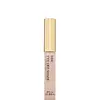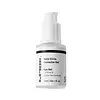What's inside
What's inside
 Key Ingredients
Key Ingredients

 Benefits
Benefits

 Ingredients Side-by-side
Ingredients Side-by-side

Water
Skin ConditioningPlacental Protein
HumectantButylene Glycol
HumectantYeast Extract
Skin ConditioningRoyal Jelly Extract
Skin ConditioningBiosaccharide Gum-1
HumectantPentylene Glycol
Skin ConditioningStyrene/Vp Copolymer
Dipotassium Glycyrrhizate
HumectantCarbomer
Emulsion StabilisingPhenoxyethanol
PreservativeAminomethyl Propanol
BufferingMagnesium Aluminum Silicate
AbsorbentCaffeine
Skin ConditioningXanthan Gum
EmulsifyingRutin
AntioxidantAcetyl Tyrosine
Skin ConditioningPaeonia Suffruticosa Root Extract
Skin ProtectingPueraria Lobata Root Extract
HumectantWater, Placental Protein, Butylene Glycol, Yeast Extract, Royal Jelly Extract, Biosaccharide Gum-1, Pentylene Glycol, Styrene/Vp Copolymer, Dipotassium Glycyrrhizate, Carbomer, Phenoxyethanol, Aminomethyl Propanol, Magnesium Aluminum Silicate, Caffeine, Xanthan Gum, Rutin, Acetyl Tyrosine, Paeonia Suffruticosa Root Extract, Pueraria Lobata Root Extract
Water
Skin ConditioningButylene Glycol
HumectantCaffeine
Skin ConditioningMaltodextrin
AbsorbentNiacinamide
SmoothingPolyacrylate Crosspolymer-6
Emulsion StabilisingPanthenol
Skin ConditioningC10-30 Alkyl Acrylate
Xanthan Gum
EmulsifyingHydroxyethylcellulose
Emulsion StabilisingAllantoin
Skin ConditioningChlorphenesin
AntimicrobialAminomethyl Propanol
BufferingBeta-Glucan
Skin ConditioningGlycerin
HumectantSodium Hyaluronate
HumectantSodium Polyglutamate
HumectantCaprylyl Glycol
EmollientEthylhexylglycerin
Skin ConditioningAcetyl Hexapeptide-8
HumectantPhenoxyethanol
PreservativeWater, Butylene Glycol, Caffeine, Maltodextrin, Niacinamide, Polyacrylate Crosspolymer-6, Panthenol, C10-30 Alkyl Acrylate, Xanthan Gum, Hydroxyethylcellulose, Allantoin, Chlorphenesin, Aminomethyl Propanol, Beta-Glucan, Glycerin, Sodium Hyaluronate, Sodium Polyglutamate, Caprylyl Glycol, Ethylhexylglycerin, Acetyl Hexapeptide-8, Phenoxyethanol
 Reviews
Reviews

Ingredients Explained
These ingredients are found in both products.
Ingredients higher up in an ingredient list are typically present in a larger amount.
Aminomethyl Propanol is used to adjust the pH of products. It is also used as a base to create other organic compounds. Having a balanced pH is important for protecting your skin.
Aminomethyl propanol is safe to use in cosmetics up to 1%. It is soluble in water.
Butylene Glycol (or BG) is used within cosmetic products for a few different reasons:
Overall, Butylene Glycol is a safe and well-rounded ingredient that works well with other ingredients.
Though this ingredient works well with most skin types, some people with sensitive skin may experience a reaction such as allergic rashes, closed comedones, or itchiness.
Learn more about Butylene GlycolCaffeine is most associated with coffee, tea, and cacao. In skincare, it helps with calming inflammation and is rich in antioxidants.
While caffeine is used to treat cellulite and and dark circles, further studies are needed to prove this. It has been believed to help with these skin conditions due to its ability to dilate blood vessels and increase blood flow.
Some studies are looking into caffeine's ability to protect against UV rays.
Learn more about CaffeinePhenoxyethanol is a preservative that has germicide, antimicrobial, and aromatic properties. Studies show that phenoxyethanol can prevent microbial growth. By itself, it has a scent that is similar to that of a rose.
It's often used in formulations along with Caprylyl Glycol to preserve the shelf life of products.
Water. It's the most common cosmetic ingredient of all. You'll usually see it at the top of ingredient lists, meaning that it makes up the largest part of the product.
So why is it so popular? Water most often acts as a solvent - this means that it helps dissolve other ingredients into the formulation.
You'll also recognize water as that liquid we all need to stay alive. If you see this, drink a glass of water. Stay hydrated!
Learn more about WaterXanthan gum is used as a stabilizer and thickener within cosmetic products. It helps give products a sticky, thick feeling - preventing them from being too runny.
On the technical side of things, xanthan gum is a polysaccharide - a combination consisting of multiple sugar molecules bonded together.
Xanthan gum is a pretty common and great ingredient. It is a natural, non-toxic, non-irritating ingredient that is also commonly used in food products.
Learn more about Xanthan Gum